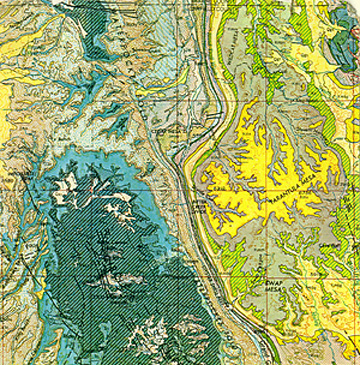

The lower map was made by the writer, generalizing units shown on a large scale map published by the U.S. Geological Survey, to depict the approximate area to be covered in the Landsat subscene.
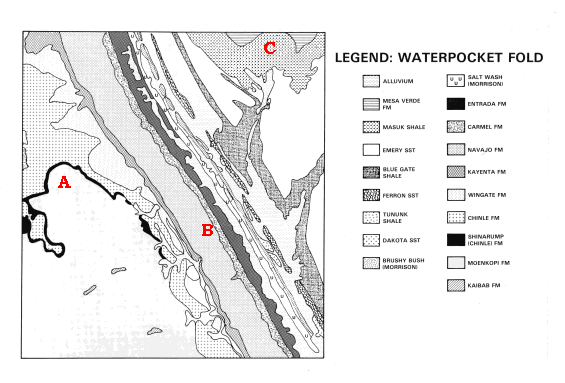
The Circle Cliffs are marked at A, the Waterpocket Fold at B, and the Tarantula Mesa at C. The individual units, or formations, are indicated, with their symbols, in the legend, in which the youngest strata are placed in the upper left (first column) and oldest in lower right (second column). Refer to this second map when the scene images are displayed; try printing it if your browser supports this.
The Waterpocket Fold was one of 11 Utah sites imaged by a 24-channel (band) scanner flown in June 1976 on NASA Aircraft Mission 340. The purpose then was to simulate the TM sensors to determine if the data are capable of rock type identification. An aerial camera with color film obtained high resolution photographs at a scale of 1:24000 (one inch on picture = 24000 inches on the ground), one of which is reproduced here

to detail the area that will shortly be examined in a Landsat scene. You can locate yourself by switching back and forth between this and the geologic map. Compare this photograph with the color PCA image made from some of the 24 channels (bands) on the Bendix airborne scanner.
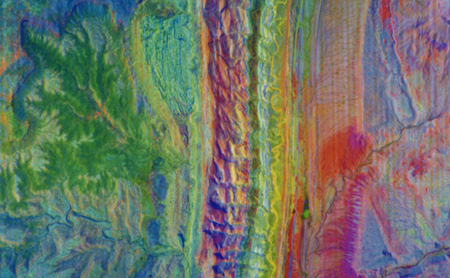
The resolution in this image is estimated to be ~ 17 ft (5 m). Data from 7 channels in the visible and near-IR were combined to generate a 6 Principal Components series of images, from which this color composite made up of the first three components was an output. Using this as an indicator of the rock unit classes, an interpreted geologic map (not shown here) was drawn in which the symbols for each Formation are the same as the field-based geologic map already examined. A strikingly strong correspondence between the two maps - published geologic and scanner data maps -is evident - confirmation that high resolution, narrow band multispectral imagery can be a powerful tool for mapping.
How well can space imagery capture this scene? The scene below
is a false color composite (band 4 = blue; 5 = green; 7 = red)
made from data acquired by the MSS onboard Landsat 1 on August 6, 1972 (scene 1014-17370).
This image was produced using JPL's VICAR imaging software program.
Except for the patch of red vegetation near the top, the colors
of the rocks are roughly similar to their natural renditions.
The Triassic units (Moenkopi; Chinle) and the Jurassic Wingate Formation are orange-brown here; the
Navajo is white and the Entrada and younger units to the east are yellow-brown. The Masuk and Blue Gate shales with interbedded
sandstones are bluish; the Mesaverde is brownish.

The same August 1972 data set was processed by VICAR using the
Karhuen-Loeve transformation program to calculate four principal
components. In the PCA composite image below, PC1 was assigned
to blue, PC2 to green, and PC3 to red. The units east of the Fold
show mainly in blue colors but so does the Navajo Formation. The
Triassic rocks appear largely in shades of red. The Kayenta is
expressed in green. The yellow patch at the left is of uncertain
identity but probably coincides with thick stands of cedars and
some pines.
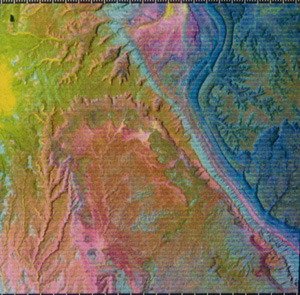
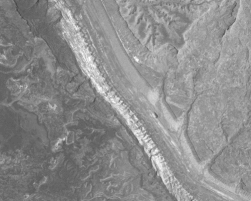 Next, inspect the TM band 1 image acquired by Landsat 4 in the
summer of 1984.Consider these observations and refer to the geologic
map as necessary: The terrain east (right) of the Fold, occupied
by units from the Blue Gate Shale to the Mesaverde Sandstone,
generally has brighter tones in keeping with the facts that the
two sandstone Formations are lighter and more reflective and the
shales have weathered, bright surfaces that mask their darker,
fresh colors.
Next, inspect the TM band 1 image acquired by Landsat 4 in the
summer of 1984.Consider these observations and refer to the geologic
map as necessary: The terrain east (right) of the Fold, occupied
by units from the Blue Gate Shale to the Mesaverde Sandstone,
generally has brighter tones in keeping with the facts that the
two sandstone Formations are lighter and more reflective and the
shales have weathered, bright surfaces that mask their darker,
fresh colors.
Look at the labelled (and degraded) version of this band to examine the tonal responses for various other units. (You may want to print this map for easier reference.)
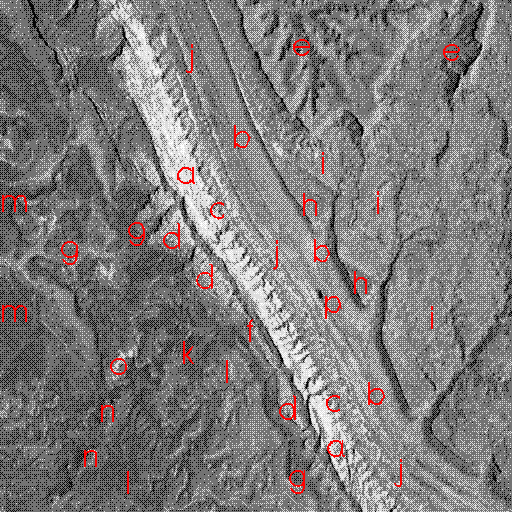
The Navajo Sandstone (a) is the brightest single unit in the scene, followed by the valley floor to the east, much of which is covered by alluvium (b). Both the Entrada (c) and Wingate (d) Sandstones are notably darker, as is the top surfaces of the Mesaverde (e). Note that the Wingate "pinches" out along the Fold towards the bottom of the image which suggests that its dip steepens making its outcrop pattern thinner. The Kayenta Formation (f) is barely discernible in the image as a thin, darker tone but the Chinle (g), also darker, has a wider outcrop pattern (it is thicker and less steeply dipping). The Emery Sandstone (h) has a darker tone than the overlying Masuk Shale (i) because, in the field, it is dark brown (similar to the Dakota Sandstone seen in the foreground of this picture)
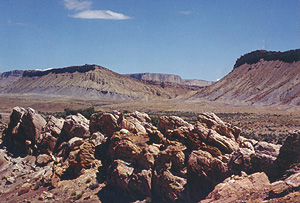
and also supports clumps of sage and other vegetation. Units in the sequence from the Salt Wash to the Ferron Sandstone (around j) are not visually separable, a consequence both of their similar colors and relative thinness. The oldest Formation, the Moenkopi , appears as a single flat-lying unit on the geologic map but in the scene its outcrop areas (mainly in lower terrain) can be subdivided visually into two subunits. In fact, in the field the Lower Moenkopi (k) is a darker reddish than the more brownish, lighter Upper Moenkopi (l) but these two stratigraphic members are not thus distinguished on the map itself. Other darker areas around (m) lie within flat-floored valleys and are presumably alluvial fill. Very light thin bands as at (n) correspond to the Shinarump Formation on the map; these in the field make up steep faces along the Circle Cliffs that reflect much more light. But, patches at (o) are extraction pits into the Shinarump which has been mined for its uranium content. The very dark blotch at (p) is a cattle watering hole made by damming the intermittent stream.
Code 935, Goddard Space Flight Center, NASA
Written by: Nicholas M. Short, Sr. email: nmshort@epix.net
and
Jon Robinson email: Jon.W.Robinson.1@gsfc.nasa.gov
Webmaster: Bill Dickinson Jr. email: rstwebmaster@gsti.com
Web Production: Christiane Robinson, Terri Ho and Nannette Fekete
Updated: 1999.03.15.